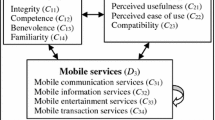Abstract
SoLoMo services are emerging mobile services, which combine different software and hardware techniques, enabling users to obtain location-based information at any time and place as well as exchange, interact, and communicate messages with other people in real time. Since SoLoMo services contain two types of the most widely used mobile applications, different users might have different needs for and expectations on these services. This study proposed a three-stage hybrid fuzzy multicriteria decision-making (MCDM) model and applied fuzzy analytic network process (FANP) and the decision-making trial and evaluation laboratory (DEMATEL) to analyze, from an angle of integral SoLoMo services, the critical factors evaluated by users in adopting SoLoMo services. In addition, this study also discussed how the users make their choices after they have weighed between the privacy consideration and the use of complete SoLoMo services. The analysis results reported that popularity degree of service, information accuracy of service, privacy risk, maintaining affection and friendship with others, and location-based store information search are the top five ones among these critical positive and negative factors considered by users while adopting SoLoMo services. Furthermore, the analysis indicated that for achieving information accuracy of service, location-based store information search, and maintaining affection and friendship with others, SoLoMo service users would tolerate more privacy risk.




Similar content being viewed by others
References
Aloudat A, Michael K, Chen X, Al-Debei MM (2014) Social acceptance of location-based mobile government services for emergency management. Telemat Inform 31(1):153–171
Asahi T, Turo D, Shneiderman B (1995) Using treemaps to visualize the analytic hierarchy process. Inform Syst Res 6(4):357–375
Buckley JJ (1985) Fuzzy hierarchical analysis. Fuzzy Set Syst 17(3):233–247
Chang B, Kuo C, Wu CH, Tzeng GH (2015) Using fuzzy analytic network process to assess the risks in enterprise resource planning system implementation. Appl Soft Comput 28:196–207
Chiou HK, Tzeng GH, Cheng DC (2005) Evaluating sustainable fishing development strategies using fuzzy MCDM approach. Omega Int J Manag Sci 33(3):223–234
Deng Z, Lu Y, Wei KK, Zhang J (2010) Understanding customer satisfaction and loyalty: an empirical study of mobile instant messages in China. Int J Inform Manag 30(4):289–300
Ellison NB (2007) Social network sites: definition, history, and scholarship. J Comput Mediat Commun 13(1):210–230
Fontela E, Gabus A (1976) Current perceptions of the world problematique. World Modeling: A Dialogue. North-Holland Publishing Company, Amsterdam
Gao L, Bai X (2014) An empirical study on continuance intention of mobile social networking services: integrating the IS success model, network externalities and flow theory. Asia Pac J Mark Logist 26(2):168–189
Gatautis R, Medziausiene A (2014) Factors affecting social commerce acceptance in Lithuania. Procedia Soc Behav Sci 110:1235–1242
Gibbs C (2008) SMS vs. MIM. RCR Wirel News 27(13):1–8
Heinemann G, Gaiser C (2015) Always on and always in touch: The new buying behaviour. In Social-Local-Mobile. Springer, Berlin
Heo JY, Kim KJ (2016) Development of a scale to measure the quality of mobile location-based services. Serv Bus pp 1–19
Ho SY (2012) The effects of location personalization on individuals’ intention to use mobile services. Decis Support Syst 53(4):802–812
Hu SK, Lu MT, Tzeng GH (2015) Improving mobile commerce adoption using a new hybrid fuzzy MADM model. Int J Fuzzy Syst 17(3):399–413
Jiang ZMZ (2013) The concept of SoLoMo and its application to library service. Res Libr Sci 12:012
Jozsef Mezei SN, Bouwman H (2011) Analytic Hierarchy Process (AHP) approach for selecting mobile service category. 10th International Conference on Mobile Business, IEEE pp 119–128
Kabir G, Akhtar Hasin A (2011) Evaluation of customer oriented success factors in mobile commerce using fuzzy AHP. J Ind Eng Manag 4(2):361–386
Kim HJ (2012) Online social media networking and assessing its security risks. Int J Secur Appl 6(3):11–18
Kim YH, Kim DJ, Wachter K (2013) A study of mobile user engagement (MoEN): engagement motivations, perceived value, satisfaction, and continued engagement intention. Decis Support Syst 56:361–370
Kim J, Park Y, Kim C, Lee H (2014) Mobile application service networks: Apple’s App Store. Serv Bus 8(1):1–27
Lee SM, Chen L (2011) An integrative research framework for the online social network service. Serv Bus 5(3):259–276
Lee SG, Park B, Kim SH, Lee HH (2012) Innovation and imitation effects in the mobile telecommunication service market. Serv Bus 6(3):265–278
Li H, Gupta A, Zhang J, Sarathy R (2014) Examining the decision to use standalone personal health record systems as a trust-enabled fair social contract. Decis Support Syst 57:376–386
Lin HF (2013) Determining the relative importance of mobile banking quality factors. Comput Stand Interfac 35(2):195–204
Lin WR (2014) The MCDM approach for evaluating mobile banking system service: a study of the cross-industries integration perspective. J Account Financ Manag Strateg 9(2):107–138
Lin LZ, Hsu TH (2011) Designing a model of FANP in brand image decision-making. Appl Soft Comput 11(1):561–573
Lin SW, Liu YC (2012) The effects of motivations, trust, and privacy concern in social networking. Serv Bus 6(4):411–424
Lin KY, Lu HP (2015) Predicting mobile social network acceptance based on mobile value and social influence. Internet Res 25(1):107–130
Lin WR, Wang YH, Hung TE (2012) Selecting mobile banking system service for consumers by using a combined DEMATEL and ANP approach. J Account Financ Manag Strateg 7(1):1–14
Lu MT, Tzeng GH, Cheng H, Hsu CC (2015) Exploring mobile banking services for user behavior in intention adoption: using new hybrid MADM model. Serv Bus 9(3):541–565
Mahrous AA, Abdelmaaboud AK (2016) Antecedents of participation in online brand communities and their purchasing behavior consequences. Serv Bus. doi:10.1007/s11628-016-0306-5
Miller CM, McIntyre SH, Mantrala MK (1993) Toward formalizing fashion theory. J Mark Res 30(2):142–157
Natarajan T, Balasubramanian SA, Manickavasagam S (2010) Customer’s choice amongst self service technology (SST) channels in retail banking: a study using analytical hierarchy process (AHP). J Internet Bank Commer 15(2):1–16
Nikou S, Bouwman H (2014) Ubiquitous use of mobile social network services. Telemat Inform 31(3):422–433
Nikou S, Mezei J (2013) Evaluation of mobile services and substantial adoption factors with Analytic Hierarchy Process (AHP). Telecommun Policy 37(10):915–929
Ogara SO, Koh CE, Prybutok VR (2014) Investigating factors affecting social presence and user satisfaction with mobile instant messaging. Comput Hum Behav 36:453–459
Park S, Oh D, Lee BG (2011) Analyzing user satisfaction factors for instant messenger-based mobile SNS. In Future Information Technology. Springer, Berlin
Phan K, Daim T (2011) Exploring technology acceptance for mobile services. J Ind Eng Manag 4(2):339–360
Pura M (2005) Linking perceived value and loyalty in location-based mobile services. Manag Serv Qual Int J 15(6):509–538
Rao S, Troshani I (2007) A conceptual framework and propositions for the acceptance of mobile services. J Theor Appl Electron Commer Res 2(2):61
Saaty TL (1990) How to make a decision: the analytic hierarchy process. Eur J Oper Res 48(1):9–26
Saaty TL (1996) Decision making with dependence and feedback: the analytic network process. RWS Publication, Pittsburgh
Saaty TL (2001) Decision making with dependence and feedback: the analytic network process. RWS Publications, Pittsburgh, pp 557–570
Saaty TL (2004) Decision making—the analytic hierarchy and network processes (AHP/ANP). J Syst Sci Syst Eng 13(1):1–35
Saaty TL (2008a) Decision making with the analytic hierarchy process. Int J Serv Sci 1(1):83–98
Saaty TL (2008b) The analytic network process. Iran J Oper Res 1(1):1–27
Salehan M, Negahban A (2013) Social networking on smartphones: when mobile phones become addictive. Comput Hum Behav 29(6):2632–2639
Schubert P, Hampe JF (2006) Mobile communities: how viable are their business models? An exemplary investigation of the leisure industry. Electron Commer Res 6(1):103–121
Sheth JN, Newman BI, Gross BL (1991) Why we buy what we buy: a theory of consumption values. J Bus Res 22(2):159–170
Shin WS, Lee HK, Kim KJ, Do Chung B (2016) Developing a quality prioritization procedure for IPTV service. Serv Bus. doi:10.1007/s11628-016-0309-2
Smith I (2005) Social-mobile applications. Computer 38(4):84–85
Sun X, Qiu J, Zhang L (2013) SoLoMo User Experience Study Using a Pivoted Parallel Coordinates. In Cross-Cultural Design. Cultural Differences in Everyday Life. Springer, Berlin, pp 336–345
The New York Times (2011) SoLoMo: Portmanteau term for the meeting of Social, Local and Mobile media. http://schott.blogs.nytimes.com/2011/02/22/solomo/?_r=1. Accessed 19 August 2016
Tseng ML, Lin YH, Chiu ASF, Liao JCH (2008) Using FANP approach on selection of competitive priorities based on cleaner production implementation: a case study in PCB manufacturer, Taiwan. Clean Technol Environ 10(1):17–29
Turban E, King D, Lang J, Lai L, McKay J, Marshall P, Pollard C, Seballos D, Viehland D, Volonino L (2009) Introduction to Electronic Commerce 2/e. Pearson Education International, New York
Wang HY (2016) Predicting customers’ intentions to check in on Facebook while patronizing hospitality firms. Serv Bus 10(1):201–222
Williams K, Durrance JC, Rosenbaum H (2009) Community informatics. Encyc Libr Inform Sci 3:1–7
Wu WW (2008) Choosing knowledge management strategies by using a combined ANP and DEMATEL approach. Expert Syst Appl 35(3):828–835
Xu H, Teo HH, Tan BC, Agarwal R (2009) The role of push-pull technology in privacy calculus: the case of location-based services. J Manag Inform Syst 26(3):135–174
Zahedi F (1986) The analytic hierarchy process-a survey of the method and its applications. Interfaces 16(4):96–108
Zeithaml VA (1988) Consumer perceptions of price, quality, and value: a means-end model and synthesis of evidence. J Mark 52(3):2–22
Zhang Z, Li Q, Zeng D, Gao H (2013) User community discovery from multi-relational networks. Decis Support Syst 54(2):870–879
Zhao L, Lu Y, Zhang L, Chau PYK (2011) Assessing the effects of service quality and justice on customer satisfaction and the continuance intention of mobile value-added services: an empirical test of a multidimensional model. Decis Support Syst 52(3):645–656
Zhou T, Li H (2014) Understanding mobile SNS continuance usage in China from the perspectives of social influence and privacy concern. Comput Hum Behav 37:283–289
Zhou T, Li H, Liu Y (2010) The effect of flow experience on mobile SNS users’ loyalty. Ind Manag Data Syst 110(6):930–946
Zhou X, Wu S, Chen G, Shou L (2014a) kNN processing with co-space distance in SoLoMo systems. Expert Syst Appl 41(16):6967–6982
Zhou Z, Jin XL, Fang Y (2014b) Moderating role of gender in the relationships between perceived benefits and satisfaction in social virtual world continuance. Decis Support Syst 65:69–79
Acknowledgments
The authors would like to thank the Ministry of Science and Technology, Taiwan, for financially supporting this research under Contract No. MOST 104-2410-H-004-135-MY3.
Author information
Authors and Affiliations
Corresponding author
Rights and permissions
About this article
Cite this article
Yang, HL., Lin, SL. The evaluation factors of adopting SoLoMo services: the hybrid fuzzy MCDM approach. Serv Bus 11, 601–629 (2017). https://doi.org/10.1007/s11628-016-0322-5
Received:
Accepted:
Published:
Issue Date:
DOI: https://doi.org/10.1007/s11628-016-0322-5




